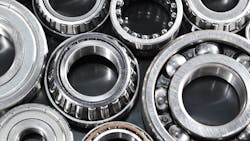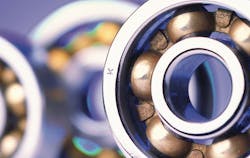The Basics of Lubricating Bearings
Specifying the right lubricants for bearings can be confusing. After all, many types of lubricants exist, and application-specific factors can range from the bearing’s relative positioning of the bearings to the seal type to the ease of relubrication. Operating conditions such as extreme weather, dirty factory environments and heavy loads add another layer of complexity to the decision.
Still, it’s critical to get the right match between lubricant and application; getting it wrong can mean the difference between a long service life and equipment failure.
“Lubricants have three functions: reducing friction between contacting surfaces, minimizing wear, and removing heat and contaminants from the contact zone,” says Frank Uherek, principal engineer at Rexnord Corp. “For slow-speed applications, the driving functions are reducing friction reduction and managing wear.”
Oil or Grease?
Lubrication experts begin the selection process with a classic tribology dilemma: oil or grease?, according to Kyle Smith, principal application engineer at the Timken Co., a major manufacturer of bearings. To answer that question, designers must examine the bearing’s structure and materials. This includes the bearings, gears, clutches and other small, ancillary parts that all affect how well the lubrication will work. Maintenance accessibility is another factor; engineers deciding on the right lubricant must think of the bearing’s service life to anticipate its needs. These key factors need to be identified early in the selection process to begin building the case for using grease or oil lubrication.
The question of grease versus oil comes first, in part, because it determines much of what makes up bearing lubrication. For grease, which tends to stay in place over time despite operational wear, the initial application is key. Equipment seals, bearing type and size, as well as the way the equipment will operate can make reapplication and filtration easy, challenging or structurally impossible. If it’s the latter, lubricants with a long service life make more sense than ones that must be filtered or replaced at service intervals.
Lubricating with oil is simpler, thanks to its comparative flexibility and ease of movement within the hardware. Oil lubrication methods vary widely, but many are equipped with flingers, dams and splash systems that help circulate the oil regularly, extending the bearing’s life without direct maintenance.
The proper interval between lubrication servicing depends on how effectively the equipment and bearing regulates itself, as well as the service life of each component (including the oil). A bearing with controlled sump temperatures and advanced filtration could theoretically control its own oil flow indefinitely, according to Smith. On the other hand, an application with only its own grease fill, operating in a dirty environment with extreme temperature fluctuations, and equipped basic labyrinth seals may require daily relubrication.
Operating Conditions
To protect bearings in unusual operating environments, experts consider how lubricants respond to the combined and changing conditions. Low-speed applications, for example, tend to be temperature-agnostic. But as speeds increase due to friction, thermal considerations become more important. They can lower oil viscosity, further reducing its effectiveness as a lubricant. Designers who anticipate such fluctuations typically forgo dip-and-splash lubrication for actively pumping oil into the bearing or gears.
Another lubrication method involves oil misting devices. These internal sprays relubricate bearings when the lubricant supply is limited, and cooling components is critical for efficiency. Mist subsystems, thus, work best where ambient conditions are carefully controlled and there are no major changes in temperature or speed.
To deal with extreme fluctuations, Smith says he turns to the industry standards. A product’s current NLGI grade, for example, can help technicians predict how the changing temperatures may affect the grease’s distribution on the bearing during replenishment and operation. Other possible solutions include multigrade oils, which let equipment adapt to changing viscosity needs at various temperatures. There are also several methods of pre-warming and pre-cooling lubricants and bearings before operation.
Properly lubricated bearings add years of service life to machinery, but the wrong lubricant can summon disaster. The complexity of the lubricating bearings is due to the enormous array of variables that determine the best one for a specific application. Selecting bearing lubricant, thus, requires expertise, either from a technician or standards and guidelines developed by researchers.
More advanced adaptations (such as lubricant additives) are best left to companies that make lubricants, Uherek warns. He notes that tampering with lubricants can have unpredictable and harmful results and should not be attempted by anyone other than lubricant suppliers.
This article was written by technical writer Lynne Peskoe-Yang. A slightly different version of it first appeared in Tribology & Lubrication Technology, the magazine of the Society of Tribologists and Lubrication Engineers, an international not-for-profit professional society headquartered in Park Ridge, Ill.

